Colospa
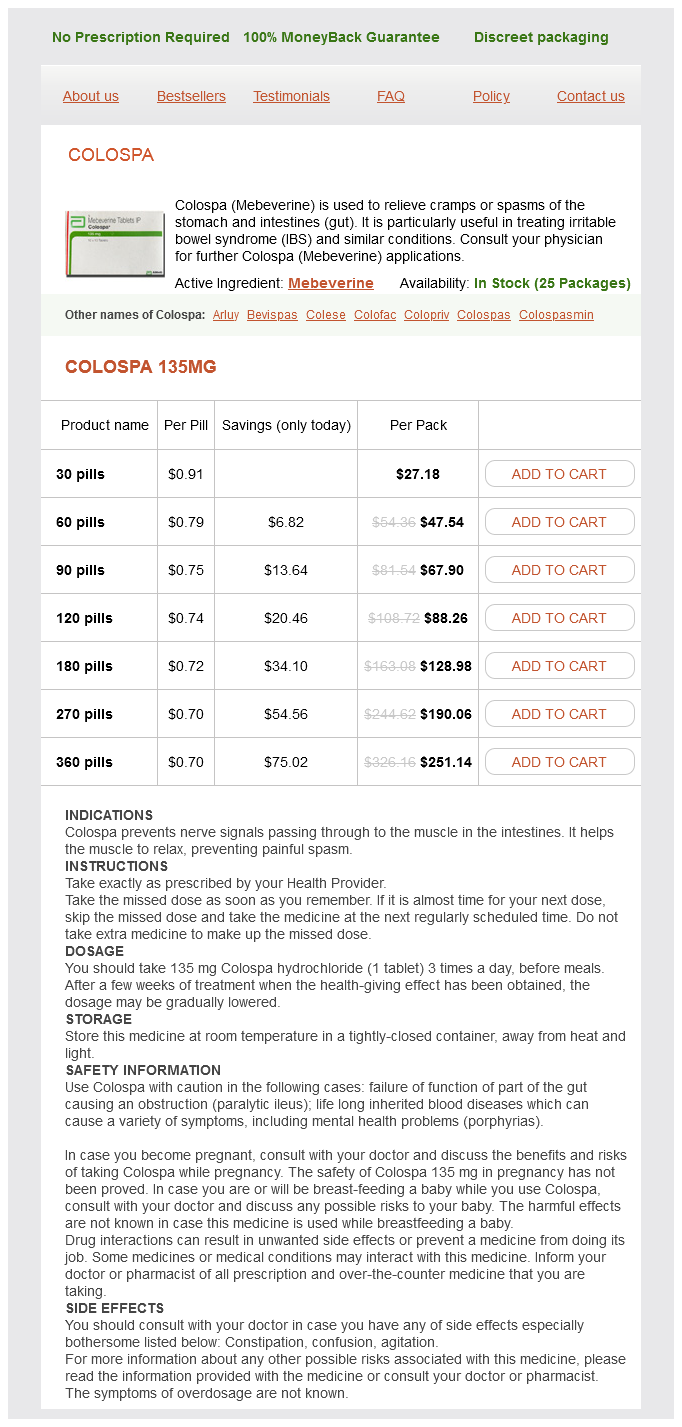
"Cheap colospa 135 mg with visa, back spasms 37 weeks pregnant".
Y. Hauke, M.B. B.CH., M.B.B.Ch., Ph.D.
Clinical Director, Touro University California College of Osteopathic Medicine
Quantification of the bleeding seen is of some help diagnostically spasms in 6 month old baby 135mg colospa fast delivery, as is the presence or absence of associated symptoms and signs muscle relaxant nursing purchase colospa 135 mg mastercard. Further stratification by age helps establish probabilities: Newborns are not old enough (not enough time) to develop full peptic ulceration spasms piriformis generic colospa 135 mg line. The latter lesions are usually suspected by signs of dyspepsia spasms after urinating buy generic colospa 135 mg online, including (but not limited to) crying, irritability centering around feedings, colic, drooling, eructation (belching), and vomiting. A toddler presenting with signs of partial esophageal obstruction (inability or unwillingness to swallow solids) and intermittent hematemesis warrants a radiographic evaluation to establish the absence of a lodged foreign body and if no clear history is obtainable regarding of the duration of the lodgment, caution is to be exercised in its removal, since penetration of or even embedding in the wall of the esophagus or adjacent structures. Such bleeding usually follows a period of protracted and usually forceful vomiting, and is usually relatively limited in volume (a few teaspoons), but it can be profuse. Esophageal erosion typically is preceded by complaints identifiable as peptic in origin in pediatrics and is rarely present in a pain free setting, which requires an extensive burn. The incidence is low compared to the widespread use of these medications and the increase in the absolute rate of this complication reflects the increasing use of these medications in the over-the-counter setting. In that regard, the low probability of Helicobacter gastritis in this age group even in the face of proven duodenal ulceration means that for each child appropriately identified by serologic testing, there will be several falsely labeled, and extension of this testing into evaluation of those who simply present with hematemesis or even just pain raises the likelihood of identifying false positives. Of these, variceal bleeding is the most frightening, since blood loss rates can approach total blood volume within an hour or less. Varices arise from portal hypertension, which in turn arises most commonly Page - 363 from cirrhosis. They most commonly present in the distal esophagus but may also be found in the gastric cardia or in the duodenum, where they can be far more difficult to treat. Identifying patients at risk for this prior to hemorrhage is far preferable, and a routine search for these findings should be undertaken at every office visit of any patient being followed for a process that can lead to cirrhosis (such as biliary atresia in the case presented). The bleeding is typically painless, as the vessels are superficial to the muscular layers and the erosion that starts the bleeding is therefore particularly shallow. The initial (or "herald") bleed may be surprisingly small as the vein rapidly collapses and clots, but the dislodgement of that clot can be followed by particularly voluminous bleeding. Those with cavernous transformation of the portal vein typically will create other intraabdominal shunts in locations which do not bleed so profusely if they can be carried into the second half of the first decade. A large-bore tube is recommended, as clots may need to be removed, and the orogastric (rather than nasogastric) route may facilitate evacuation. Icing of the saline is not required and in smaller patients, may produce significant hypothermia. In contrast, the patient whose bleeding is suspected as coming from a nonintrinsic or otherwise low-risk source does not require immediate endoscopy. This would typically occur in patients who are bleeding from a deep ulcer in the duodenal bulb with sufficient pylorospasm to prevent any regurgitation of blood into the stomach. Radiographic contrast studies are dependent on identification of a moderate-sized ulcer crater, and lack sensitivity in identifying risks for rebleeding such as a visible vessel or adherent clot. Even varices are difficult to identify radiographically, and endoscopy offers the ability to intervene to reduce the risk of rebleeding via variceal band ligation or intravascular injection of a sclerosing agent. Optimal therapeutic decision making for pediatric patients with peptic ulcer disease is best left to gastroenterologists who are most familiar with the most recent studies and recommendations. The patient who presents with bleeding only from the anus produces a separate (but overlapping) diagnostic tree. As discussed in the patient who presents with hematemesis, the initial evaluation centers around rapid estimation of the volume of blood lost and the risk of ongoing or recurrent bleeding. It usually presents with other signs of intestinal obstruction, partial or complete, and bleeding is typically one of the lesser findings, and is most Page - 364 commonly occult. Typically the exclusion is not complete, and if (repeated) inadvertent exposure shows no sign of reaction, the restrictions can be lifted. But recurrent reactions can be severe if of the acute hypersensitivity (type I) variety. This can result in sufficient vomiting and diarrhea to cause significant volume depletion, and if uncertain as to the residual reactivity, a formal staged dietary challenge with nursing support. It typically presents with punctate bleeding best characterized as streaks of blood with small streaks of mucus in otherwise normal stool in an otherwise thriving infant. This compares to infection, allergy or other more generalized inflammatory processes of the distal bowel where loose stool indicates inflammation, and therefore goes hand in hand with more mucus and blood. The only time the bleeding disappears in nodular lymphoid hyperplasia is in the face of liquid stools, in which case the streaks of mucus and blood are dissolved in the diarrhea but can be found by occult blood testing.

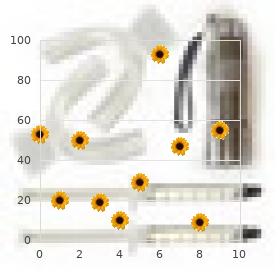
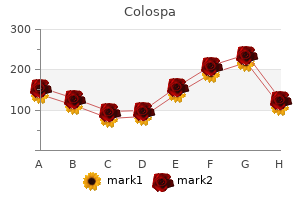
Even though several of these are considered nonpathogenic by the outdated allopathic conceptualizations that are still hypnotized by Pasteur and Koch spasms synonyms colospa 135mg visa, their presence is generally inconsistent with optimal health and their eradication is rewarding for both doctor and patient muscle relaxer 93 buy colospa 135 mg mastercard. For example muscle relaxant injection for back pain buy 135mg colospa, the finding of a mild degree of Candida albicans ("+1" on a 0-4 scale) might be considered insignificant; however if no other pathogens are identified muscle relaxant erowid discount colospa 135mg visa, and the secretory IgA, lactoferrin, and lysozyme levels are highly elevated, then the clinician is justified in determining that the patient is having a hypersensitivity reaction to an otherwise "benign" yeast. Recently I worked with a patient with rheumatoid arthritis in whom we found mild Citrobacter freundii ("+1") which was barely enough to arouse my interest until I noted that he had an exaggerated mucosal inflammatory response; eradication of the bacteria lead to an immediate and profound reduction in his symptomatology and systemic inflammation. Some patients will have abdominal pain, nausea, vomiting, diarrhea, weight loss as well as anorexia, flatus, and eosinophilia. Patients may have mild general symptoms such as fatigue and dyscognition ("brain fog"); gas and intestinal bloating following consumption of carbohydrates are common. Candida produces an immunosuppressive myotoxin called gliotoxin as well as an IgA-destroying protease and can cause watery diarrhea, particularly in elderly, ill, and immunosuppressed patients. It is always present in the gastrointestinal tract of women with recurrent yeast vaginitis. Bacterial overgrowth of the small bowel can be objectively documented with measurement of post-carbohydrate hydrogen/methane, but I consider a history of postprandial gas and bloating to be sufficiently diagnostic. The single best test for the assessment of gastrointestinal dysbiosis is a comprehensive stool analysis and comprehensive parasitology examination performed by a specialty laboratory that provides bacterial culture, yeast culture, microscopic exam, and measurement of sIgA to assess mucosal immune response, along with markers of inflammation such as lactoferrin, calprotectin, and/or lysozyme. Frequent gas and bloating indicates excess gastrointestinal fermentation by yeast and/or overgrowth of aerobic bacteria. Abdominal pain, chronic constipation, and/or diarrhea are clear indications for stool testing; however clinicians must remember that some of the most heavily colonized patients will have no gastrointestinal symptoms. Thus, assessment and treatment for gastrointestinal dysbiosis is not unnecessary simply because the patient lacks gastrointestinal symptoms. Comprehensive stool analysis assesses digestion, absorption, inflammation, and comprehensive parasitology examinations (x3) assess for bacteria, yeast, and parasites. These tests should be performed by a specialty laboratory rather than a regular medical or hospital laboratory. Citrobacter freundii: Also known as Citrobacter rodentium, Citrobacter freundii is described as a gram-negative aerobe and facultative anaerobe; it may cause gastroenteritis in humans. Animal studies have shown that this bacterium can induce an intense inflammatory response in the gastrointestinal tract that resembles inflammatory bowel disease. Like several other intestinal bacteria, most strains of Citrobacter freundii produce hydrogen sulfide which interferes with mitochondrial function and energy production and appears to contribute to ulcerative colitis. However, intestinal infection with Endolimax nana can cause a peripheral arthropathy that is clinically similar to rheumatoid arthritis and which remits with effective parasite eradication. Entamoeba histolytica: E histolytica can induce tissue damage, amebic colitis, and liver abscess. Klebsiella pneumoniae: Many cases of gastrointestinal colonization with this microorganism produce no acute gastrointestinal symptoms such as nausea, vomiting, constipation, or diarrhea. Patients may have mild general symptoms such as fatigue and dyscognition ("brain fog"). Gastrointestinal and urinary tract colonization with Proteus is associated with rheumatoid arthritis92 and ankylosing spondylitis. Pseudomonas aeruginosa: Many cases of gastrointestinal colonization with this microorganism produce no acute gastrointestinal symptoms such as nausea, vomiting, constipation, or diarrhea. Pseudomonas aeruginosa is a gram-negative bacteria, produces endotoxin and can cause antibiotic-associated diarrhea. Patients with multiple sclerosis show evidence of a heightened immune response against Pseudomonas aerugeniosa, suggesting the possibility of immune crossreactivity. These terms refer to gram-positive Enterococcus species such as Enterococcus faecalis, which cause urinary tract infections, bacteremia, intra-abdominal infections, and endocarditis. Enterococci produce lipoteichoic acid which is pro-inflammatory in a manner similar to endotoxin from gram-negative bacteria, and these gram-positive bacteria also appear to produce a superantigen. Staphylococcus aureus: Gastrointestinal colonization with Staph aureus should be eradicated immediately due to the well-known inflammatory consequences of the toxins 16 Nutritional Perspectives: Journal of the Council on Nutrition of the American Chiropractic Association Vol.
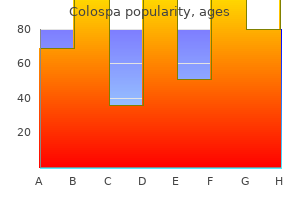
The authors stressed that careful diagnostic evaluation using intravascular ultrasound and contrast venography are important parts of the evaluation before any of the mentioned procedures spasms with cerebral palsy cheap colospa 135 mg on-line. Their report also emphasized that patency rates are generally in the 90% range at three and five years after stenting muscle relaxant mechanism cheap 135mg colospa with visa, and bypass and mortality rates are less than 1% spasms calf cheap 135mg colospa otc. In addition muscle relaxant pharmacology cheap colospa 135 mg on line, Meissner cited several studies of the various interventions indicating improvements in venous severity scores and quality of life in the majority of patients after successful interventions. Seager and coauthors150 reviewed endovascular stenting for chronic venous obstruction in the European Journal of Vascular and Endovascular Surgery, 2016. There was significant heterogeneity of the studies, but the data suggested that improved ulcer healing and improved quality of life were frequently cited in the available studies. While the authors affirmed the need for prospective randomized trials, they also stressed that endovascular stenting should be considered for patients with symptomatic chronic venous obstruction. Delis and coauthors151 presented additional data confirming the utility of deep venous procedures to improve venous outflow in Annals of Surgery, 2007. This analysis evaluated venous outflow and muscle pump function as well as intensity of venous claudication in 16 patients with documented venous outflow obstruction in one limb. All outflow veins were successfully stented and the authors observed improvements in muscle pump function and venous outflow. Reflux increased in all patients, but this did not prevent a significant improvement in the intensity of venous claudication. The authors concluded that symptomatic improvement, coupled with improved venous outflow and muscle pump function, make stenting to improve venous outflow an attractive alternative in these highly-selected patients. Meissner and associates141 confirmed that there have been encouraging results with the use of vein bypass of deep venous obstructions. Readers are encouraged to read this article for details of this procedure that might be helpful for carefully selected patients. Clinical success depends on a stepwise approach in which compression is a mainstay of therapy. Careful diagnosis supported by Doppler imaging leads to improved therapeutic choices and improved outcomes. Additional strong clinical data is necessary to help guide the choices of direct ulcer treatment with dressings or skin substitutes. Dialysis Access Successful management of patients requiring hemodialysis depends on acquiring and maintaining vascular access. Rose and coauthors152 supplied an important perspective on the approaches that can yield the best results in Surgical Clinics of North America, 2013. The financial burden of this disease is significant, accounting for 6% of the Medicare budget in 2009. Hoggard and coauthors153 offered perspectives on the general features of managing chronic renal disease patients in Seminars in Dialysis, 2008. The authors opened their discussion by stating the two main objectives of their guidelines: first, they wished to provide practical, easy-to-recognize criteria for the early identification of patients who may require chronic hemodialysis; second, an algorithm for delivering optimal dialysis access for this patient group was offered. The authors stressed that the success of autogenous arteriovenous fistulas for chronic dialysis access (the preferred access type) depends on venous drainage that is open and undamaged. The authors also emphasized the savings in both morbidity and cost associated with the creation of functioning autogenous arteriovenous fistula access for chronic hemodialysis. For this goal to be achieved, aggressive efforts to prevent venous outflow injury are required. Hoggard and coauthors next reviewed the mechanisms of venous injury resulting from venipuncture and venous catheter placement. Venous injury can occur at the time of venipuncture or it may develop gradually over the interval that an indwelling device is present. Short-term intravenous catheter use was characterized by areas of endothelial denudation in the vein where the catheter was residing. Longer-term use led to vein wall thickening, increased numbers of smooth muscle cells at the site of vein wall puncture, and multiple areas of catheter adherence to the vein wall. At these attachment sites, thrombus formation and collagen deposition were observed. Another autopsy study disclosed thrombus formation in nearly one-third of cannulated veins at two weeks following catheter insertion. Subclavian catheters are also associated with a significant risk of vein injury that may contribute to ipsilateral upper-extremity dialysis-access failure. In one study, vein stenosis or occlusion was found in 57% of patients having subclavian catheters removed.
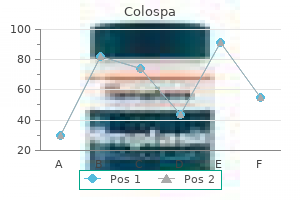
Syndromes
- Urine osmolality
- You have had surgery on your carotid artery
- Legumes and lentils
- Try NOT to take over-the-counter cold and sinus medicines that contain decongestants or antihistamines. These drugs can increase BPH symptoms.
- Fatigue caused by losing blood over time
- Rigid muscles
- Dehydration

Thus spasms right side under ribs buy colospa 135mg otc, any physician spasms during pregnancy generic colospa 135 mg with amex, nurse spasms right before falling asleep purchase colospa 135 mg fast delivery, or other clinical worker needs to have basic knowledge about the pathophysiology of pain and should be able to use at least simple first-line treatments muscle relaxant before massage order colospa 135 mg line. Unlike "special pain management," which should be reserved for specialist physicians with specific postgraduate training in complex pain syndromes, knowledge of "general pain management" is a must for all other health care workers to prepare them for the majority of patients in pain with common pain syndromes. The main focus of the Guide is to address the following four pain syndromes: acute post-traumatic postoperative pain, cancer pain, neuropathic pain, and chronic noncancer pain. The editors understand the barriers and future needs regarding good pain management. These barriers include lack of pain education and a lack of emphasis on pain management and pain research. In addition, when pain management does feature in government health priorities, there are fears of opioid addiction, the high cost of certain drugs, and in some cases, poor patient compliance. In developing countries, the available resources for health care understandably focus on the prevention and treatment of "killer" diseases. Yet most such disease conditions are accompanied by unrelieved pain, which is why pain control matters in the developing world, according to Prof. However, it is a sad reality that the medicines that are essential for relieving pain often are not available or accessible. There are numerous reports, some of them published in major medical and science journals, about the deficits of adequate pain management, predominantly in developing countries in all regions of the world. For the pain specialist in developed countries, plenty of detailed information is available, but for the non-pain specialist and other health care providers, including nurses and clinical staff in many other regions of the world, who have to deal with patients in pain, there is a lack of a basic guide or manual on pain mechanisms, management, and treatment rationales. This is of particular concern in areas of the world where, outside the main urban areas, there is no access to information about pain etiology or management and no access to a pain specialist. The educational grant program, the "Initiative for Improving Pain Education," addresses the need for improved education about pain and its treatment in developing countries by providing educational support grants. These grants are intended to improve the scope and availability of essential education for pain clinicians of all disciplines, taking into account specific local needs. The result is this Guide, which is intended to provide Introduction concise and up-to-date-information in a novel curriculum structure for the medical practitioner in countries belonging to the developing world. It will also serve medical faculties by suggesting core curriculum topics on pain physiology and management. It is believed that the project will encourage medical colleges to integrate these educational objectives into their local student and nursing curriculums. It will provide the non-pain specialist with basic relevant information-in a form that is easily understood-about the physiology of pain and the different management and treatment approaches for different types and syndromes of pain. Any practitioner who deals with pain problems must be aware of the entire range of pathophysiological and psychopathological problems that are commonly encountered in pain patients, and must therefore have access to a reasonable range of medical, physical, and psychological therapies to avoid imposing on the patients and society any additional financial and personal costs. Therefore, this book will encourage the management of patients with acute and chronic pain, since it is well understood from the literature that even basic education has a considerable impact on the quality of analgesic therapy for the patient. The editors appreciate the enthusiasm and efforts put in by the volunteer authors of this Guide, without whom this book would not have been possible. Many have experience in the problems faced by health care providers in the developing world. They have tried to project their thoughts into particular situations and settings: "Can I cope with what is expected of me, working as a doctor or nurse or health care provider in a developing country and facing a wide range of pain problems? The purpose is to provide the reader with various approaches to the management of some common pain management problems. Treatment algorithms presented are based on the review of available literature and experience in pain clinics, with a specific view on the potential local limitations in the developing world. Instead of a textbook approach with independent chapters written in a systematic manner, the Guide tries to follow a problemorientated learning path. The chapters are intended to Introduction be sufficiently broad and understandable to be of value to the nonspecialist. The structure, including questions and answers, pearls of wisdom, and illustrative case reports, as well as valuable literature suggestions for further reading, will, we hope, make the Guide a helpful companion and aid to pain management. All readers are invited to contribute to the improvement of further editions by sending their comments and suggestions to the editors.
